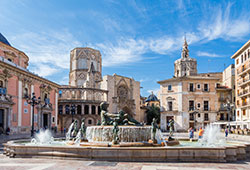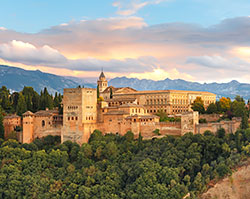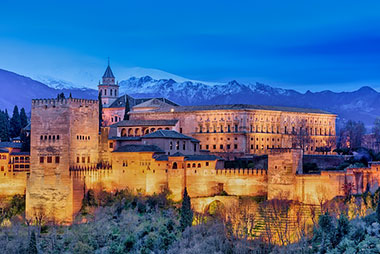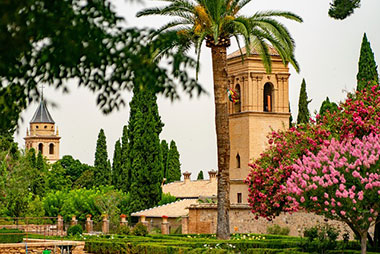Spain
Moorish / Spanish Colonial Architecture and Flamenco
Spain, with its captivating blend of history, culture, and natural beauty, is a destination that promises unforgettable experiences for retirees. From the enchanting streets of Madrid to the pulsating rhythm of Seville and the architectural wonders of Barcelona, each city unveils a different facet of this diverse country.
Whichever destination you choose, you can expect warm hospitality, fascinating history, delicious cuisine and beautiful beaches to enjoy.
Madrid: The Enchanting Capital

Photo by Elxeneize / Adobe Stock |
Begin your Spanish sojourn in the enchanting capital of Madrid, where elegant boulevards, world-class museums, and lively tapas bars await your discovery. Immerse yourself in the vibrant atmosphere of the city's bustling squares, such as the iconic Puerta del Sol and the majestic Plaza Mayor. Art enthusiasts will revel in the Museo del Prado, home to masterpieces by renowned Spanish painters like Goya and Velázquez. |
| Don't miss the opportunity to indulge in a traditional Spanish feast at one of Madrid's lively tapas bars, where you can savor the tantalizing flavors of chorizo, gambas al ajillo, and patatas bravas. |
Barcelona: Cosmopolitan Charm

Photo by Enes / Unsplash |
Barcelona, a vibrant city in Spain, boasts a prime coastal location with stunning beaches along the northeastern shores of the Mediterranean Sea. Barcelona's modernist architecture, vibrant markets, and a rich Catalan culture make it a popular destination for both sun-seeking tourists and culture enthusiasts. Marvel at the awe-inspiring architectural wonders of Antoni Gaudí, such as the whimsical Sagrada Família and the colorful Park Güell. |
Stroll down the vibrant pedestrian street of Las Ramblas, lined with shops, cafes, and street performers, and immerse yourself in the lively atmosphere of La Boqueria market. As the sun sets, head to the Gothic Quarter to discover hidden gems, charming squares, and cozy taverns where you can enjoy a glass of local wine and soak in the authentic ambiance.
Seville: A Flamenco Paradise

Photo by Fred P. / Adobe Stock | In Seville, lose yourself in the enchanting labyrinth of narrow streets, where the scent of orange blossoms fills the air and the passionate rhythm of flamenco dances captivates your senses. Explore the magnificent Alcázar, a stunning Moorish palace adorned with exquisite tile work and lush gardens. Visit the awe-inspiring Seville Cathedral, the largest Gothic cathedral in the world, and climb the Giralda tower for breathtaking views of the city. |
Indulge in traditional Andalusian cuisine, savoring dishes like gazpacho, salmorejo, and tender braised Iberian pork. To fully immerse yourself in the soul-stirring world of flamenco, catch a live performance at one of Seville's intimate tablaos, where the heartfelt melodies and passionate footwork will leave an indelible impression.
Valencia: The City of Arts and Sciences

Photo by jose Vgluis / Adobe Stock | Continue your Spanish escapade in the vibrant city of Valencia, where a harmonious blend of history and modernity awaits. Immerse yourself in the futuristic architecture of the City of Arts and Sciences, a sprawling complex designed by Santiago Calatrava that houses a planetarium, an opera house, and a science museum. Stroll through the picturesque old town, wandering its narrow alleys, and visit the stunning Valencia Cathedral, home to the revered Holy Grail. |
For a taste of authentic Valencian cuisine, indulge in the mouthwatering paella, a regional specialty that showcases the rich flavors of saffron-infused rice, succulent meats, and fresh seafood.
Granada: Moorish Splendor

Photo by Kavalenkava/ Adobe Stock | Another must-see destination on your Spanish odyssey is Granada, a city steeped in Moorish splendor and nestled in the foothills of the Sierra Nevada mountains. Explore the iconic Alhambra, a breathtaking palace complex that transports you back in time with its intricate Islamic architecture, lush gardens, and ornate courtyards. Lose yourself in the winding streets of the Albaicín neighborhood, where whitewashed houses, hidden plazas, and stunning views of the Alhambra create a romantic atmosphere. |
As the evening falls, immerse yourself in the lively atmosphere of the city's vibrant tapas scene, hopping from one traditional bar to another, indulging in a variety of tantalizing small plates.
Malaga: Sun-Kissed Paradise

Photo by Horváth Botond / Adobe Stock | Nestled on the stunning Costa del Sol, Malaga is a sun-kissed paradise that entices retirees with its year-round mild climate and breathtaking coastal scenery. Start your exploration at the Alcazaba, a Moorish fortress offering panoramic views of the city and the Mediterranean Sea. Stroll along the vibrant promenade of La Malagueta beach and soak up the sun's warmth or wander through the charming streets of the historic center, lined with tapas bars and shops. |
Art enthusiasts will be thrilled to visit the birthplace of Pablo Picasso and explore the Picasso Museum, showcasing an extensive collection of the artist's works. With its laid-back atmosphere, delicious cuisine, and beautiful surroundings, Malaga is a top choice for retirees seeking a relaxed beachside getaway.
Bilbao: Culture and Gastronomy

Photo by David Vives / Pixaby | Located in the Basque Country, Bilbao is a vibrant city renowned for its rich cultural heritage and exceptional gastronomy. The iconic Guggenheim Museum is a must-visit, housing contemporary art exhibitions within an architectural masterpiece designed by Frank Gehry.Take a stroll through the historic Old Town, known as the Casco Viejo, where narrow streets are lined with charming shops, traditional taverns, and the bustling Mercado de la Ribera, one of Europe's largest covered markets. |
Indulge in the city's famous pintxos, Basque-style tapas, at the numerous bars in the city center. For nature enthusiasts, a visit to the nearby Urdaibai Biosphere Reserve offers breathtaking landscapes and opportunities for outdoor activities. Bilbao provides retirees with a unique blend of cultural experiences, culinary delights, and natural beauty, making it an enticing destination in Spain.
Best Time to Visit:
Both Spring (March to May) and Fall (September to November) months offer pleasant weather and fewer crowds. Keep in mind that specific events, festivals, and regional weather variations can impact the best time to visit certain areas in Spain.
Spring (March to May):
Spring is an excellent time to visit Spain as the weather starts to warm up, and the tourist crowds are relatively smaller compared to the summer months. You can enjoy pleasant temperatures and blooming landscapes. The average temperature ranges between 50°F to 70°F
(10°C to 21°C). This season is particularly ideal for exploring cities like Madrid, Barcelona, and Seville, as well as regions like Andalusia and Valencia.
Summer (June to August):
Summer is peak tourist season in Spain due to its sunny weather and lively atmosphere. Coastal regions, such as Costa del Sol, Costa Brava, and the Balearic Islands (Ibiza, Mallorca, Menorca), are popular destinations for beachgoers and party enthusiasts. However, be prepared for high temperatures, especially in southern Spain. The average Summer temperature ranges between 70°F to 90°F (21°C to 32°C). If you visit during this season, consider coastal areas, beach resorts, or cooler regions like northern Spain and the Pyrenees.
Fall (September to November):
Autumn is another excellent time to visit Spain, with warm temperatures and fewer crowds compared to summer. The weather remains pleasant, making it ideal for exploring cities, historical sites, and cultural attractions. The average Fall temperature ranges between 50°F to 70°F (10°C to 21°C). Fall is a fantastic time to visit regions like Catalonia, Basque Country, Andalusia, and the wine regions of La Rioja and Ribera del Duero.
Winter (December to February):
Winter in Spain offers a milder climate compared to other European countries. While northern Spain and mountainous areas experience colder temperatures and even snow, southern Spain and the Canary Islands have relatively mild weather. The average Winter temperature ranges between 40°F to 60°F (4°C to 15°C). Winter is a great time to visit cities like Madrid, Barcelona, and Granada, where you can explore cultural sites, enjoy holiday festivities, and hit the slopes in the Pyrenees or Sierra Nevada.
Travel Planning Tips:
Plan Ahead: Research and plan your itinerary in advance to make the most of your time in Spain. Consider the locations you want to visit, the duration of your stay, and any specific attractions or activities you don't want to miss.
Cash and Currency: Spain uses the Euro (€) as its currency. Make sure to have some cash on hand for small expenses, but most places accept credit cards.
Travel Insurance: Ensure that you have comprehensive travel insurance that covers medical expenses, trip cancellation, and any potential emergencies. Review the policy details and know how to access medical assistance if needed.
Language, Local Customs and Etiquette: While Spanish is the official language in Spain, English is widely spoken in tourist areas. However, learning a few basic Spanish phrases can enhance your experience and interactions with locals. Dress modestly when visiting churches or religious sites, and respect local customs and traditions. Respect local laws and customs in Spain such as any restrictions on smoking, public drinking, and photography in certain areas.
Stay Hydration:Drink plenty of fluids and carry a water bottle especially during the summer months.
Sun Protection:Spain enjoys a sunny climate, so it's essential to protect yourself from the sun. Wear sunscreen, a hat, and sunglasses, and seek shade during the hottest hours of the day to prevent sunburn and dehydration.
Travel Documents: Ensure you have a valid passport with at least six months' validity remaining. Check if you require a visa to enter Spain, depending on your nationality, and ensure you have all the necessary travel documents.
Remember to check the latest travel advisories and guidelines from your country's government before your trip to Greece, as situations and requirements may change.
Accommodations:
Spain offers a wide range of accommodation options, including hotels, hostels, vacation rentals, and rural guesthouses. Book in advance, especially during peak seasons, to secure the best deals and availability.
Transportation:
Spain has an extensive transportation network that includes trains, buses, and domestic flights. Consider your preferred mode of transportation based on the distance and convenience of your chosen destinations.
- Domestic Flights: If you're traveling long distances within Spain, consider domestic flights for faster connections. Major cities have airports with both full-service and low-cost airlines operating domestic routes.
- Trains: Spain has an extensive and efficient train network, making it a convenient way to travel between cities. Renfe is the national train operator, offering high-speed trains (AVE) and regional services.
- Buses: Buses are a popular mode of transportation for both short and long distances in Spain. Companies like ALSA and Avanza operate intercity and regional bus services, connecting various cities and towns.
- Rental Cars: Renting a car is a great option if you plan to explore rural areas and smaller towns. Be aware of parking regulations, toll roads, and traffic rules, especially in city centers.
- Taxis: Taxis in Spain are generally safe and reliable. However, it's always wise to exercise caution. Use licensed taxis, avoid unmarked vehicles, and consider sharing your trip details with someone you trust. Taxis: In urban areas, you can usually hail a taxi on the street if the rooftop light is illuminated and the "libre" sign is displayed, indicating that the taxi is available. Simply raise your hand to signal a taxi driver.
- Taxi Apps: SeverTaxis in Spain usually accept cash and major credit cards. However, it's a good idea to carry some cash for smaller transactions or in case of card payment issues. Extra charges may apply for nighttime rides, airport pickups, or additional passengers. Several taxi-hailing apps are available in Spain, such as MyTaxi (now known as FREE NOW), Uber, and Cabify. These apps allow you to book taxis, track their arrival, and even pay digitally.
- Public Transportation:
Spain's major cities have comprehensive public transportation systems, including metros, buses, and trams. Purchase travel cards or individual tickets, depending on your planned usage.
Safety Tips:
- Safety Precautions:
Spain is generally a safe country, but it's always wise to take precautions. Be aware of your surroundings, especially in crowded tourist areas, and keep an eye on your belongings to prevent theft.
- Vaccinations: Check with your healthcare provider or travel clinic about recommended vaccinations before visiting Spain. Routine vaccines such as measles-mumps-rubella (MMR), tetanus, pertussis (DTaP), varicella (chickenpox), and flu shots are generally advised. Depending on your travel plans and personal health, additional vaccines like hepatitis A and B may be recommended.
- Medical Facilities: Familiarize yourself with the location of medical facilities, clinics, and hospitals near your travel destinations. Keep a list of emergency contact numbers and addresses readily available.
- Prescription Medications: If you take prescription medications, ensure you have an ample supply for the duration of your trip. Carry them in their original packaging, along with copies of prescriptions, in case you need to refill or replace them while in Greece.
- Hygiene and Food Safety: Practice good hygiene by regularly washing your hands with soap and water, or using hand sanitizer when handwashing facilities are not available. Be cautious with food and water consumption, opting for bottled water and eating at reputable establishments. Peel fruits and vegetables, and avoid consuming undercooked or raw food.
- Sun Protection: Spain experiences high sun exposure, especially during the summer months. Protect yourself from the sun by wearing sunscreen (with a high SPF), a wide-brimmed hat, sunglasses, and lightweight clothing. Seek shade during the hottest hours of the day to avoid heatstroke and sunburn.
- Stay Hydrated: Maintain adequate hydration by drinking plenty of water, especially in warmer months or when participating in outdoor activities. Carry a refillable water bottle and stay hydrated throughout the day.
- COVID-19 Precautions: Stay informed about the latest COVID-19 guidelines and restrictions in Spain. Follow local regulations, wear masks where required, practice social distancing, and maintain good hand hygiene. Stay updated on travel advisories and requirements from your home country as well.
- Emergency Numbers: Familiarize yourself with the emergency contact numbers in Spain, including the general emergency number (112), local police, and medical services.
- Travel Advisories Stay updated on current events, local regulations, and any travel advisories when traveling abroad. Visit the US Government State Department Travel Advisories web site to check on the status of your destination.
| |
 Alhambra, Granada Photo by Julio Gm / Pexals
 Alhambra garden Photo by Tobi J. / Pixabay
 Photo by Samuel-Perales / Adobe Stock
 Sagrada Família, Barcelona Photo by Enrico Perini
 Mosque-Cathedral, Córdoba
Photo by Horváth Botond / Adobe Stock
|
 Alhambra, Granada
Alhambra, Granada Alhambra garden
Alhambra garden Photo by Samuel-Perales / Adobe Stock
Photo by Samuel-Perales / Adobe Stock Sagrada Família, Barcelona
Sagrada Família, Barcelona Mosque-Cathedral, Córdoba
Mosque-Cathedral, Córdoba